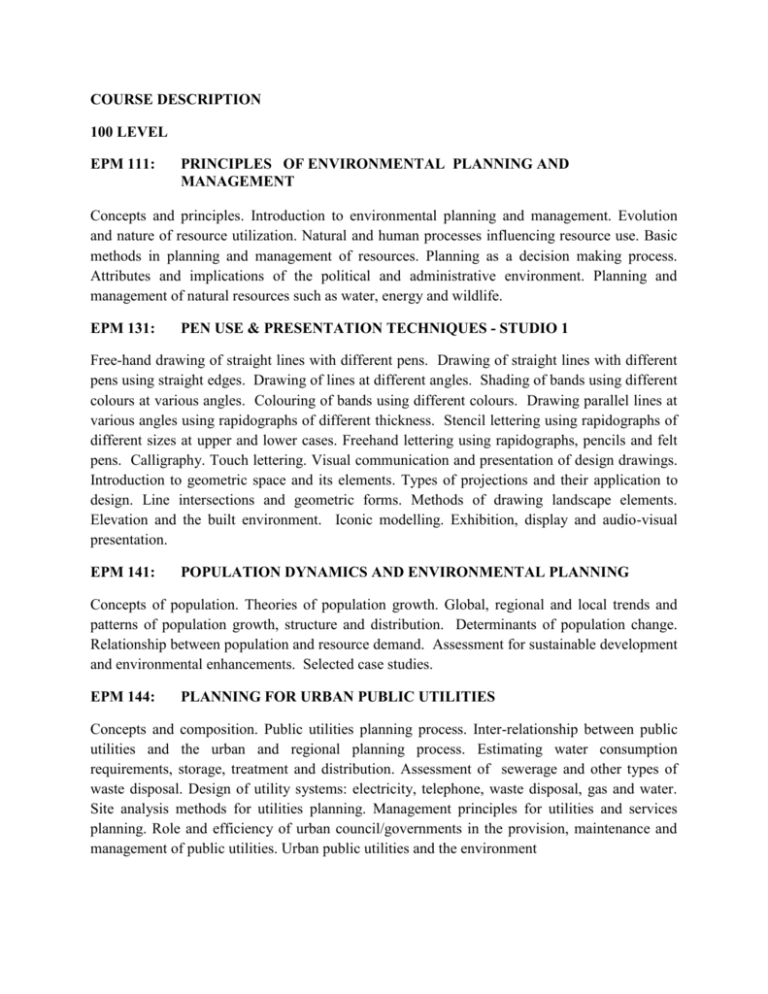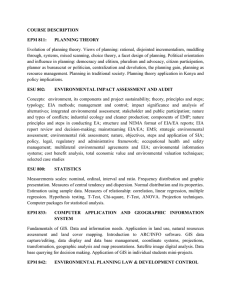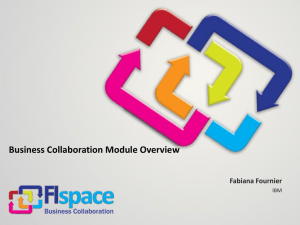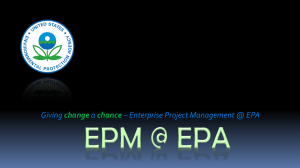Environmental Planning & Management Course Descriptions
advertisement

COURSE DESCRIPTION 100 LEVEL EPM 111: PRINCIPLES OF ENVIRONMENTAL PLANNING AND MANAGEMENT Concepts and principles. Introduction to environmental planning and management. Evolution and nature of resource utilization. Natural and human processes influencing resource use. Basic methods in planning and management of resources. Planning as a decision making process. Attributes and implications of the political and administrative environment. Planning and management of natural resources such as water, energy and wildlife. EPM 131: PEN USE & PRESENTATION TECHNIQUES - STUDIO 1 Free-hand drawing of straight lines with different pens. Drawing of straight lines with different pens using straight edges. Drawing of lines at different angles. Shading of bands using different colours at various angles. Colouring of bands using different colours. Drawing parallel lines at various angles using rapidographs of different thickness. Stencil lettering using rapidographs of different sizes at upper and lower cases. Freehand lettering using rapidographs, pencils and felt pens. Calligraphy. Touch lettering. Visual communication and presentation of design drawings. Introduction to geometric space and its elements. Types of projections and their application to design. Line intersections and geometric forms. Methods of drawing landscape elements. Elevation and the built environment. Iconic modelling. Exhibition, display and audio-visual presentation. EPM 141: POPULATION DYNAMICS AND ENVIRONMENTAL PLANNING Concepts of population. Theories of population growth. Global, regional and local trends and patterns of population growth, structure and distribution. Determinants of population change. Relationship between population and resource demand. Assessment for sustainable development and environmental enhancements. Selected case studies. EPM 144: PLANNING FOR URBAN PUBLIC UTILITIES Concepts and composition. Public utilities planning process. Inter-relationship between public utilities and the urban and regional planning process. Estimating water consumption requirements, storage, treatment and distribution. Assessment of sewerage and other types of waste disposal. Design of utility systems: electricity, telephone, waste disposal, gas and water. Site analysis methods for utilities planning. Management principles for utilities and services planning. Role and efficiency of urban council/governments in the provision, maintenance and management of public utilities. Urban public utilities and the environment EPM 145: INTEGRATED ENVIRONMENTAL MANAGEMENT Concepts. Dimensions and types of integration. Procedures and processes. Policies and legislation. Mobilization and coordination of stakeholders. Ecological, socio-cultural, economic and political considerations. Role of strategic planning. Sustainable production and consumption. Environmental considerations in project cycle. Information dissemination and sharing. Selected case studies. 200 LEVEL EPM 222: ENVIRONMENTAL PLANNING AND MANAGEMENT TECHNIQUES Evolution of planning and management techniques. Introduction to basic techniques and procedures of environmental planning and management: environmental standards, co-ordination and control, zoning and subdivision controls. Use of legal planning tools and abatements of nuisance. Regulatory processes such as taxes, legislation and policy. Management decision models. Quantitative techniques. Meetings as human resource mobilization technique. Oral presentation techniques. EPM 232: GEOMATIC SURVEYING & ENVIRONMENTAL MAPPING I – STUDIO 2 This unit introduces students of environmental planning and management to the tools and techniques of geomatic surveying and environmental mapping. Its content: History and development of surveying; Definition and process of surveying; Principles of surveying; Systems of referencing positions, directions and heights. Methods and types of surveying; Concept of survey measurement and errors: type and causes of errors, precision and accuracy, and error propagation. Chain surveying: principles of chain surveying; equipment; procedure of chain surveying: reconnaissance, field observations and presentation; obstacles in chain surveying and how to overcome them. EPM 242: RESOURCE USE PLANNING Meaning of Resource. Theories of resource use. Types: human, land, atmospheric, marine and fresh water. Biodiversity. Resource systems, characteristics and influences. Relationship among resources. Patterns and techniques of utilization. Policy and legislation. Resource use and management processes. Environmental considerations. Planning and management. Management of shared resources. Case studies. EPM 244: WASTE MANAGEMENT PLANNING Definitions, types, sources, nature and composition. Individual and group perceptions. Management: generation, collection, transportation and disposal. Recycling and treatment. Regulatory instruments: standards, permits and licences. Economic instruments: charges, market creation, subsidies, deposit refund systems. Education and awareness creation. Enforcement institutions and their capacities. Waste management policies and plans : preparation, implementation and monitoring . Case studies. EPM 246: PUBLIC FINANCE PLANNING Nature and scope of public finance. Revenue generation and development process. Budgeting. Taxation: types, incidence and impact on investment and development. Theory of private and public goods and their externalities. Modern issues in public finance theory and practice. Public finance administration. National debt burden and government borrowing. Public finance in Kenya. EPM 251: COMPUTER APPLICATION IN ENVIRONMENTAL PLANNING AND MANAGEMENT Introduction to computers; Application of computer in environmental planning and management. Collection and analysis of environmental planning and management data. Computer methods of analysing complex environmental planning and management problems and issues. EPM 254: GIS & REMOTE SENSING IN ENVIRONMENTAL PLANNING AND MANAGEMENT Fundamentals of GIS. Data and information needs. Application in land use, natural resources assessment and land cover mapping. Introduction to ARC/INFO software. GIS data capture/editing, data display and data base management, coordinate systems, projections, transformation, geographic analysis and map presentations. Concepts of remote sensing. Components of remote sensing model. Various platforms and data forms. Ground truthing. Use of remote sensing images. Detection of electromagnetic energy. Orbital remote sensing systems: geostationary, sun-syncrhonous, manned satellite systems, receiving and distribution centres. Future of earth observation programmes. Landsat and spot. Computer processing techniques. Application of Remote Sensing in Environmental Planning and Management. EPM 255: CONSERVATION AREA PLANNING & MANAGEMENT History of conservation, theories of conservation, theories in conservation areas, types of conservation areas, characteristics of conservation areas, threats to the conservation areas, policies and legislations, effectiveness of planning and management approaches in conservation areas, sustainable planning and management approaches of conservation, the future of conservation areas in Kenya EPM 256: CLIMATE CHANGE ADAPTATION AND MITIGATION Definition of climate change adaptation and mitigation, frameworks – UN, National policy and legislations, theoretical underpinning, approaches and methodologies, factors affecting climate change adaptation and mitigation, benefits of climate change adaptation, adaption and mitigation strategies in the built, economic and natural environment, the future adaptation and mitigations in Kenya 300 LEVEL ESU 300: ENVIRONMENTAL IMPACT ASSESSMENT AND AUDIT Concepts: environment, impact and assessment. Historical development. Components of EMP. EIA Process and methods. Typology of impacts. Auditing: nature and steps. Interdisciplinary approaches to impact analysis. Impact significance. Analysis of alternatives. Stakeholder involvement. EIA report writing. Institutional arrangements: policy, legislation, information systems and logistics. EIA report review and decision making. Practical assignment. ESU 301: ENVIRONMENTAL POLICY AND LAW Definitions and evolution. Conceptualisation, formulation and implementation. Problems and issues. Types: conservation and pollution control legislation, common, civil, constitutional and international law. Conventions, agreements and treaties. Conventional and customary institutions: functions, authority, coordination and constraints. Enforcement instruments of noncompliance and sanctions. Police power, eminent domain. Selected case studies. ESU 302: APPLIED STATISTICS Measurement: scales, precision, reliability and validity. Frequency distribution and graphic presentation. Measures of central tendency. Measures of dispersion. Measures of relationships: correlation and linear regression. Hypothesis testing – Chi square, F-Test, ANOVA. ESU 304: RESEARCH METHODS Meaning of research. Objectives, types, approaches and significance. Empirical Research steps: topic selection and factors affecting choice. Problem articulation. Research design. Literature Review. Measurement and operationalization. Methods of data collection. Sampling. Instrumentation. Data processing, analysis and interpretation. References, bibliography and appendix. ESU 305: ENVIRONMENTAL ECONOMICS Macro-economic theories. Quantitative methods and their application to Environmental Planning and Management. Role of economic models in resource planning, utilization and management. Resource valuation and accounting methods. Environmental cost-benefit analysis. Economic analysis of environmental quality and management. Economics of development and environment. EPM 332: GEOMATIC SURVEYING & ENVIRONMENTAL MAPPING II – STUDIO 3C This unit deepens students’ knowledge in techniques of geomatic surveying and environmental mapping. Its content: Traversing: rectangular and polar coordinates; types of traverses; procedure; detection of mistakes. Computation of areas: parcels with straight and irregular boundaries. Levelling: operational terms; instruments and procedure of levelling; Applications of levelling. Tacheometry: systems; principles in each system; procedures in stadia tacheometry. Other methods of environmental mapping: Plane table and compass surveying. Cartographic techniques; principles of draftsmanship; Map scales; Text and graphic images production; Cartographic symbols. Sources of mapping data. Map design and construction. Map elements and map compilation; Factors of map design; Map production procedure; Map revision. EPM 341: DEVELOPMENT CONTROL IN ENVIRONMENTAL PLANNING AND MANAGEMENT Concepts of development and control. Historical development. Objectives. Provisions and stipulations. Process. Instruments: police power, de facto, incentive, public ownership, eminent domain, permits, leases, covenants, servitude, statutory regulations, plan preparation and enforcement. Participatory/advocacy development control institutions. Liaison Boards Development control policies in Kenya. Problems and constraints. Case studies. EPM 345: SPATIAL ORGANIZATION IN ENVIRONMENTAL PLANNING AND MANAGEMENT Theories of spatial location. Spatial interaction and diffusion. Land use relationships. Analysis of spatial constraints to development. Planning and management of spatial structures and processes. Traditional and conventional approaches to the planning and management of human activities in space. Selected case studies. EPM 371: SITE AND NEIGHBOURHOOD PLANNING - STUDIO 3B Concepts and objectives. Importance of space in site pattern. Form and structure. Planning process. Policies and legislation. Infrastructure, amenities and service provision. Landscaping for recreation, leisure and aesthetics. Environmental considerations. Financing site and neighbourhood planning. Plan implementation, monitoring, management and administration. New approaches to site planning. Design: function, layout and character. Presentation. Case studies. EPM 372: RURAL PLANNING - STUDIO 3A Definitions. Rural planning approaches and techniques. Policies. Planning and management of specific rural issues: land and settlement, energy, water, wildlife, transport and communication. Role of stakeholders. Base map preparation. Rural land use. Rural site analysis, planning and design. Studio plan preparation and presentation. ESU 303 PROJECT MANAGEMENT, PLANNING & EVALUATION Concepts and uses of feasibility studies. Types. Project cycles. Team work and feasibility study preparation. Financial and economic viability and stake-holder analysis. Institutional and environmental analysis. Design and terms of references. Selection of consultants. Improving the quality of project feasibility studies. EPM 381: FIELD ATTACHMENT AND PLANNING PRACTICE The objective of field attachment to a planning office is to expose the students to professional planning practice. The attachment will last for duration of not less than eight weeks. During this time, the students will work under experienced professional planners both lecturers and field practitioners. Areas of exposure/internship shall include planning and management of environmental and specific resources, development control mechanisms, planning and management techniques, ethical and professional obligations. At the end of the field attachment and planning practice/internship, the student will be required to submit a written planning report for examination. 400 LEVEL CORE UNITS EPM 424: ENVIRONMENTAL ACTION PLANNING Concepts, principles and foundations. Historical development. Objectives and process. Structural considerations. Support institutions. Importance of public participation, advocacy and indigenous knowledge. Integration with economic/development framework. Preparation and implementation. Environmental investment programmes. National and World Bank policies on Environmental Action Planning. Case studies of status of EAP in selected countries. Field study and preparation of Environmental Action Planning. EPM 451: PLANNING FOR RECREATION AND LEISURE Definitions and historical development. Socio-cultural, economic, ecological and political factors. Processes and procedures. Assessment of supply, demand and carrying capacity. Planning standards. Development and improvement of recreation and leisure resources. Recreation, leisure and environmental management .Planning and design of recreation and leisure facilities. Selected case studies. EPM 452: PLANNING AND MANAGEMENT OF HOUSING DEVELOPMENT Concept of housing. Indigenous and conventional types. Building materials and ecological adaptability. Housing needs, demand , supply and affordability. Densities and occupancy ratio. Design typologies and their implications. Alternative approaches to housing. Planning standards. Housing policy in Kenya. Housing and environmental management. EPM 456: PLANNING AND MANAGEMENT OF URBAN SLUMS AND SQUATTER SETTLEMENTS Definitions and characteristics. Factors and problems associated with their development. Urban planning responses. Problems and constraints. Management and challenges. Community involvement and mobilization. Planning and design process. Selected case studies. EPM 463: ENVIRONMENTAL MONITORING MODELLING, ANALYSIS AND SYSTEMS Definitions of terms. Systems theory and modelling used in environmental planning and management. Methodologies of systems analysis. Conceptualisation and design of environmental planning models. Systems life cycle. Problem identification and feasibility assessment. EPM 464: DISASTER PREPAREDNESS AND MANAGEMENT History of disasters, theories and principles of disaster management, types of disasters, causes and effects of disasters, policy and legislative frameworks, disaster management strategies, experiences in disaster management, best practices in disaster management, components of disaster preparedness and management in Kenya, case studies. EPM 471: URBAN PLANNING - STUDIO 4A History and theories of urbanization. Types of urban land uses. Integration of environmental aspects in planning urban land uses. Provision and management of infrastructure, amenities and services. Study and design of urban land uses. Techniques for preparation of urban master plans. Management of specific urban problems. Studio project design and report. EPM 472: REGIONAL PLANNING - STUDIO 4B Concepts and historical development. Objectives and theories. Delineation of regional environmental planning units. Regional development problems and planning policies. Environmental considerations. Regional land use models. Regional planning process. Regional resource use and conflicts. Regional development institutions. Design and preparation of regional development action area plans. Project planning, analysis and implementation. Studio plan preparation and presentation. EPM 473: URBAN DESIGN - STUDIO 4C Concepts of urban environments. Components, structure, function and activities. Simple- scaled drawing of buildings and land use plans. Elements of urban physical form. Human and natural dimensions of urban design. Design method, process, criteria and standards and enforcement. Policies, plans, guidelines and programmes. Design enforcement. Future prospects of urban design. Computer assisted design. EPM 492: PLANNING/RESEARCH PROJECT Each student is expected to undertake a planning/ research project with staff supervision. The subject of such project/research may fall under empirical, land use/urban master plan, site/landscape design, project evaluation, feasibility study, environmental impact assessment or any other approved by the Departmental Board.









